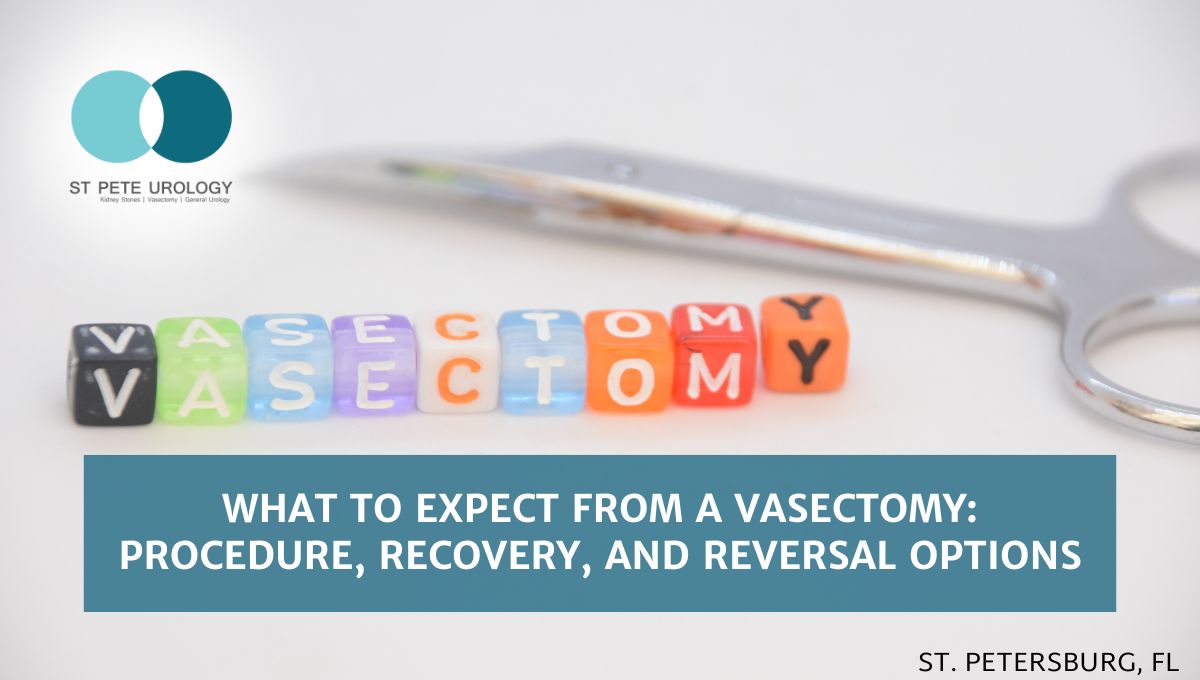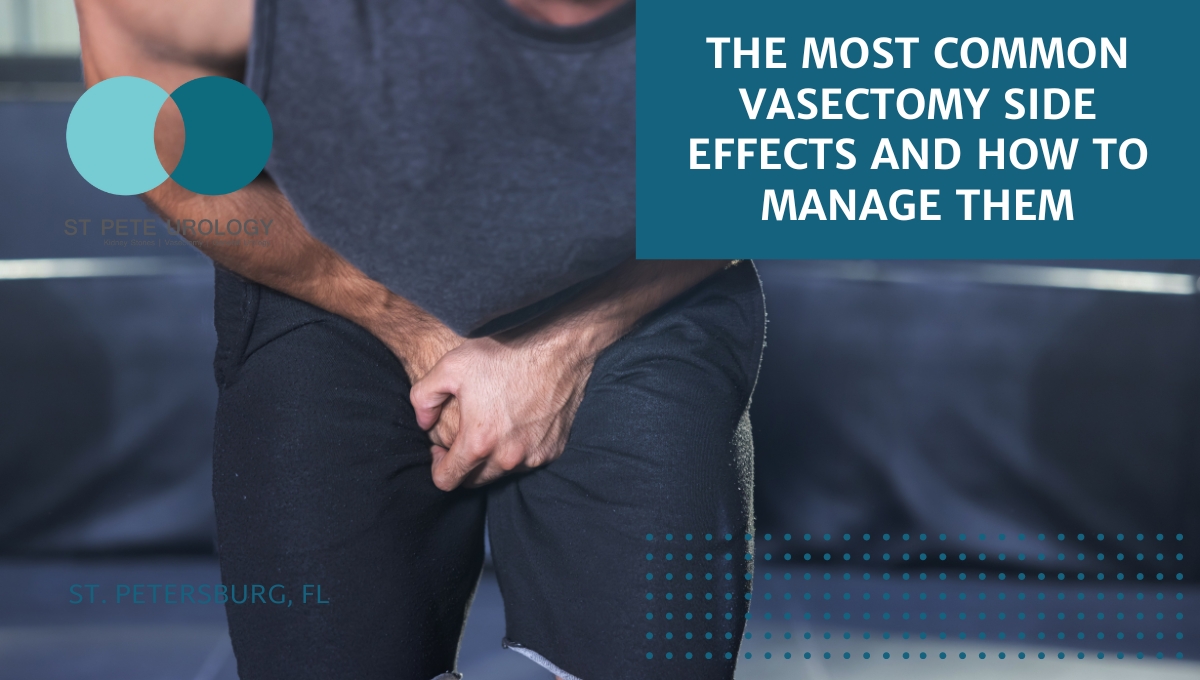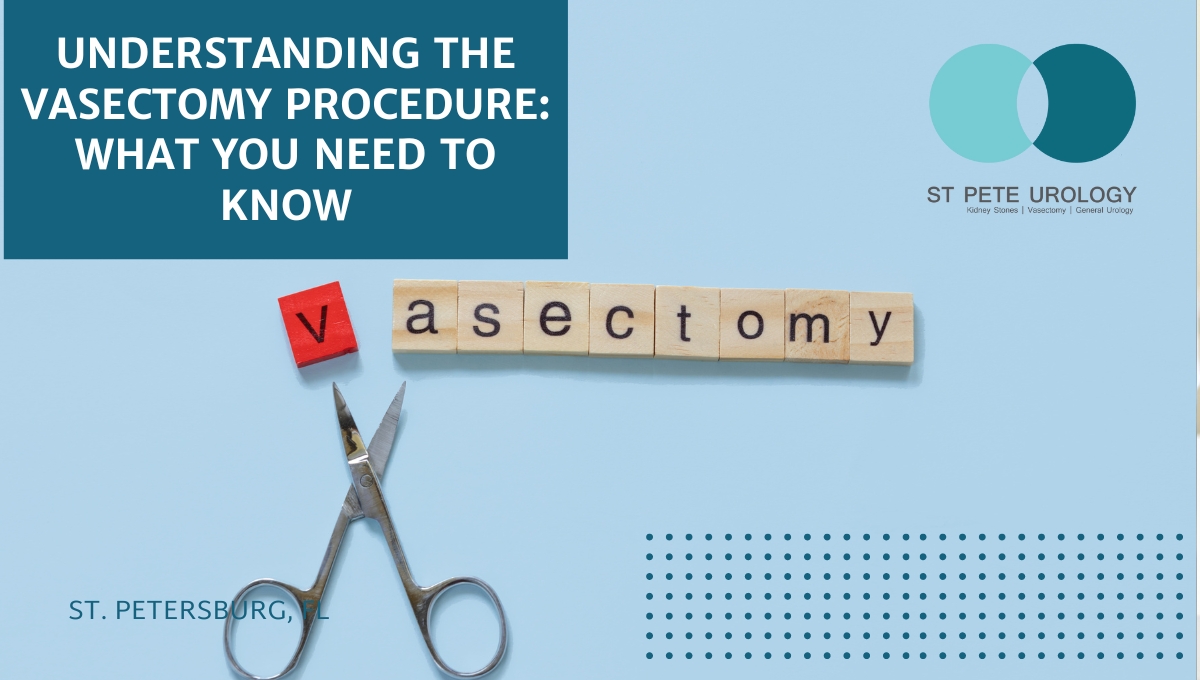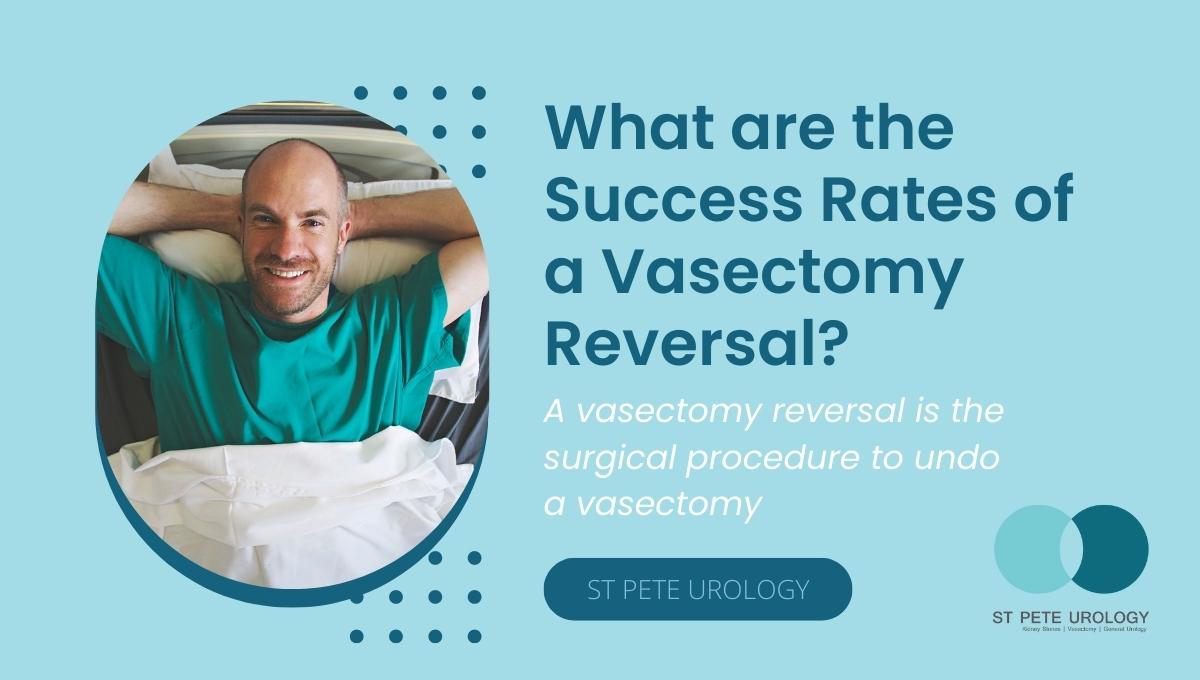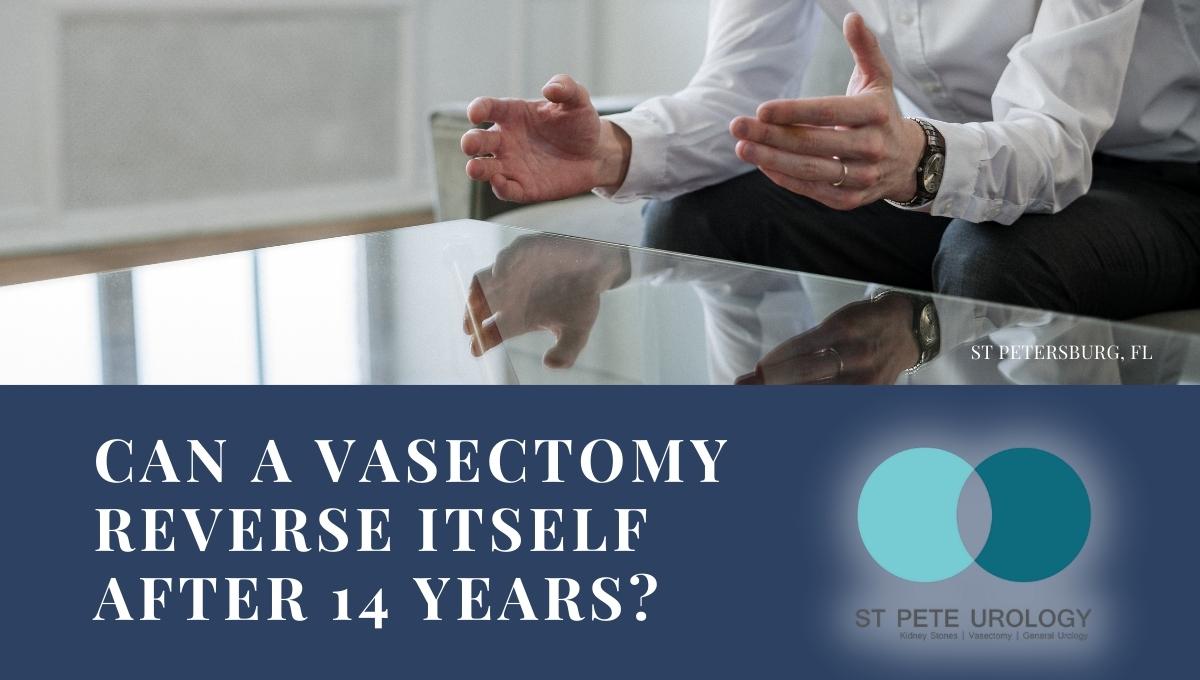Considering a vasectomy procedure? Learn what to expect during the procedure, recovery timeline, success rates, and fertility restoration options including vasectomy reversal from St Pete Urology.
Continue readingHow Does the Vasectomy Procedure Function? – Dr. Nicholas Laryngakis
Key Takeaways:
- The vasectomy procedure is relatively quick and painless and is performed by making a small incision in the scrotal skin and removing a small portion of the vas deferens.
- Post-surgery care involves avoiding heavy lifting or strenuous activity for the first 48 hours and avoiding ejaculation for 5 to 7 days.
- St. Pete Urology is dedicated to providing the highest quality of care for their patients, with a focus on patient education and transparent communication.
Demystifying the Vasectomy Procedure
For many men, the thought of undergoing a vasectomy can be both confusing and intimidating. However, gaining a better understanding of the procedure and its function can help ease those concerns. Dr. Nicholas Laryngakis is a board-certified urologist at St. Pete Urology. He provides an insight into the vasectomy procedure and what to expect during and after the surgery.
Quick and Painless: The Vasectomy Process
According to Dr. Laryngakis, “The vasectomy will take about 10 to 20 minutes to perform.” The process begins with the injection of a local anesthetic into the scrotal skin adjacent to the vas deferens. This step “affords almost immediate anesthesia,” ensuring patients remain comfortable and pain-free throughout the procedure.
After, a small incision is made in the scrotum. This incision allows the surgeon to expose the vas deferens. Next, a small portion of this tube is then removed, and the severed ends are either clipped, tied with suture, or cauterized. Typically, the incisions are closed with a single dissolvable suture. This generally heals within 7 to 10 days.
Post-Surgery Care and Precautions
After the surgery is complete, Dr. Laryngakis recommends that patients can “take showers the following morning after the procedure.” It’s essential to follow specific postoperative guidelines to ensure a smooth recovery process. Furthermore, reduces the risk of complications.
For the first 48 hours after the procedure, patients should avoid heavy lifting or strenuous activity. To ease any swelling, ice packs can be periodically applied to the scrotum during the first 24 to 36 hours. After, the patient may gradually begin physical activities as comfort allows.
In terms of resuming sexual activity, Dr. Laryngakis advises that “ejaculation should generally be avoided for about 5 to 7 days.”
Promoting Confidence and Trust: St. Pete Urology
At St. Pete Urology, the team of skilled professionals led by Dr. Nicholas Laryngakis is dedicated to providing the highest quality of care for their patients. With a focus on patient education and transparent communication. Furthermore, they help dispel concerns and fears surrounding urological procedures, such as vasectomy.
Located in St. Petersburg, Florida, St. Pete Urology offers a comprehensive range of services to address a variety of urological issues. Trust the experienced team at St. Pete Urology for a safe, comfortable, and effective vasectomy procedure. For more information or to schedule an appointment, visit their website or contact their office today.
References:
- “Recovering from a Vasectomy: What to Expect After You Get Snipped.” 26 Feb. 2020, https://www.iowaclinic.com/urology/recovering-from-vasectomy/.
- “Male Vasectomy Procedure | What is a … – Planned Parenthood.” https://www.plannedparenthood.org/learn/birth-control/vasectomy.
- “After Surgery Instructions for Vasectomy – Michigan Medicine.” https://www.med.umich.edu/1libr/urology/VasectomyPostOp.pdf.
What You Need to Know About Vasectomy Reversal
Key Takeaways:
- A vasectomy reversal is a procedure that can help restore fertility in men who have had a vasectomy.
- The success rate of a vasectomy reversal ranges between 40 and 80% and is contingent on many factors, including age and timing.
- There are options available for financing a vasectomy reversal and support groups to help answer questions and provide emotional support.
Introduction
 A vasectomy reversal is a surgical procedure that reverses a vasectomy. During a vasectomy, the doctor cuts, blocks, or seals the tubes called vas deferens, thus preventing sperm from reaching semen. During the procedure, a skilled doctor reconstructs the tubes to restore the man’s fertility. Men who have had a vasectomy, but now want to become fathers can benefit from a vasectomy reversal.
A vasectomy reversal is a surgical procedure that reverses a vasectomy. During a vasectomy, the doctor cuts, blocks, or seals the tubes called vas deferens, thus preventing sperm from reaching semen. During the procedure, a skilled doctor reconstructs the tubes to restore the man’s fertility. Men who have had a vasectomy, but now want to become fathers can benefit from a vasectomy reversal.
What are the Pros and Cons of Vasectomy Reversal?
Vasectomy reversals offer many potential benefits, although there are also a few risks to consider.
Pros
The most obvious benefit of a vasectomy reversal is the opportunity to have children. This procedure may provide a better chance of getting pregnant than taking fertility drugs or attempting in vitro fertilization. Additionally, the procedure is typically less costly than other fertility treatments, and there is no egg retrieval, which simplifies the procedure.
Cons
The success of a vasectomy reversal procedure can vary significantly, and there is no guarantee that it will work. The procedure also involves risks such as infection, bleeding, and negative reactions to the anesthesia, none of which should be taken lightly. It is also important to keep in mind that the procedure does involve some degree of discomfort, and it is possible that a second procedure would be necessary for full reversal to occur.
The Surgery
During a vasectomy reversal procedure, the doctor first makes a small opening in the patient’s scrotum. He then reconnects the two previously cut ends of the vas deferens tubes, a process called vasovasostomy. Depending on the skill of the doctor and the condition of the tubes, he may need to construct a new vas deferens. This process is called epididymovasostomy. Then, the doctor uses sutures to secure the reconstructed tubes.
Recovery time can vary from person to person, depending on the type of procedure, with some taking as little as a few days to recover, while others may need up to six weeks for complete healing. Generally, it is best to avoid strenuous activity and heavy lifting for several weeks after the procedure.
Risks
Like any other surgery, there are potential risks associated with a vasectomy reversal. These may include infection, negative reactions to the anesthesia, excessive bleeding, or development of a hematoma. Additionally, the procedure may not restore fertility, and a repeat surgery may be necessary.
Cost and Insurance Coverage
The average cost of a vasectomy reversal is approximately $5,000, though this number may vary depending on several factors and where the procedure is performed. Fortunately, some insurance companies may cover the cost, although it is important to note that coverage depends on the specific plan. If insurance is not an option, payment plans or financial assistance options may be available.
Success Rates
The success rate of a vasectomy reversal procedure is contingent on many factors. Generally, however, the success rate typically ranges between 40 and 80%. Factors that can affect the procedure’s success are the age of the patient, the amount of time since the initial vasectomy, and the type of procedure used.
Support and Resources
It is important for those considering a vasectomy reversal to understand that it is not a decision to be taken lightly, and that there are many factors to consider before undergoing the procedure. Fortunately, there are several support groups available that provide information, advice, and emotional support. Additionally, there are numerous online resources available, such as the Vasectomy Reversal Guide, for individuals seeking more information about the procedure.
Conclusion
A vasectomy reversal is a procedure that can offer a chance at fatherhood to men who have had a vasectomy but have now changed their minds. While there are many potential benefits to having a reversal, men should weigh the risks before making a decision. Fortunately, there are several options for affording the procedure, and there are support groups available to provide information, advice, and emotional support.
At St Pete Urology, we understand that a vasectomy reversal is an important and personal decision. Our team is dedicated to providing the highest quality of care and support to ensure the best possible outcome of the procedure.
References:
- “Vasovasostomy – Mayo Clinic.” 10 Aug. 2015, https://www.mayoclinic.org/tests-procedures/vasectomy-reversal/multimedia/vasovasostomy-video/vid-20125797
- “Vasectomy Reversal | Stanford Health Care.” https://stanfordhealthcare.org/medical-treatments/v/vasectomy-reversal.html.
- “Risks of Vasectomy Reversal.” https://www.bestvasectomy.com/risks-of-vasectomy-reversal/.
How Much Does a Vasectomy Cost?
Key Takeaways:
- Vasectomies are a permanent form of contraception and are typically a cost-effective solution.
- Costs of vasectomies can range from under a thousand dollars to several thousand depending on associated fees.
- St Pete Urology is a reliable and experienced urology practice offering a range of services including vasectomies and reversals.
 Vasectomies have become an increasingly popular form of permanent contraception for couples who have decided not to have children. But along with this growing popularity comes the question of how much does a vasectomy cost? In this article, we will address the procedure, cost factors, advantages and disadvantages, and more.
Vasectomies have become an increasingly popular form of permanent contraception for couples who have decided not to have children. But along with this growing popularity comes the question of how much does a vasectomy cost? In this article, we will address the procedure, cost factors, advantages and disadvantages, and more.
Introduction
A vasectomy is a surgical procedure performed by a qualified physician or urologist that renders a male patient sterile by sealing off the tubes that carry sperm from the testes. Patients must be informed of the permanent nature of a vasectomy before they proceed with the procedure. Couples may consider a vasectomy for various reasons. These reasons include family planning, a desire for longer-term contraception, and personal health considerations.
What Does a Vasectomy Involve?
The vasectomy itself is a relatively straightforward procedure typically performed in a physician’s office. After receiving local anesthesia, the healthcare provider cuts and seals the patient’s vas deferens. These tubes transport sperm to the penis along with seminal fluid, and this procedure is performed using surgical techniques. The entire procedure is minimally invasive and typically only requires a few stitches in the scrotum. However, potential side effects can include swelling, infection and bleeding.
Cost Overview
There is no single price for a vasectomy. Costs can vary depending on several factors. These factors include the complexity of the procedure, the office’s location, the urologist’s fees, the type of anesthesia administered, and any prescribed medications. Generally speaking, however, the basic procedure rarely costs more than $1,000 and is often covered under insurance, although some policies may have exclusions. Anesthesiology and aftercare, such as follow-up visits, can add anywhere from $200-$500 or more to the overall cost. In some cases, a sliding scale fee system may be available, which adjusts the fee based on the patient’s income level. Alternatively, financing options may be offered to assist with covering the costs of the procedure.
Advantages of Vasectomy
The main benefit of a vasectomy is that it is a permanent form of contraception. Additionally, a vasectomy is considered a minimally invasive procedure. Furthermore, it can typically be completed in less than an hour at a doctor’s office. When factoring in the recovery time, a vasectomy proves to be a cost-effective method of birth control. This cost-effectiveness becomes evident when compared to other long-term forms of contraception.
Disadvantages of Vasectomy
The main disadvantage of a vasectomy is that it is irreversible. The technique of vasectomy reversal, or vasovasostomy, is available, but it is not always successful or cost-effective, and can require multiple surgeries. Veins may form in the connective tissues that are cut and create scarring, which can reduce or prevent their function. Additionally, the procedure itself can involve complications such as infection, swelling and bleeding. Lastly, a vasectomy can also have emotional and psychological consequences for a couple if they decide at a later point that they want to have children.
Conclusion
A vasectomy is a permanent form of contraception that can be a cost-effective solution for couples who have decided not to have children. The cost of a vasectomy can range from under a thousand dollars, to several thousands depending on associated fees. Additionally, the procedure can have associated risks and potential emotional effects. When considering a vasectomy, it is important for couples to manage expectations, understand the potential risks, plan for any changes that may occur, and be aware of any potential for the procedure to be reversed.
St Pete Urology is a trusted urology practice located in St Petersburg, Florida. Their team of experienced registered nurses, nurse practitioners, and physician assistants partner with highly skilled and experienced urologists to provide the highest quality of urological care. St Pete Urology has earned a positive reputation among patients and their peers, and they offer a wide range of services that include vasectomies and vasectomy reversals.
References:
- “5 Facts You Should Know Before Having a Vasectomy.” 10 Nov. 2020, https://www.pennmedicine.org/updates/blogs/fertility-blog/2019/march/5-facts-you-should-know-before-having-a-vasectomy.
- “Vasectomy Pros and Cons – Oswego Health.” https://www.oswegohealth.org/health-library/story/4b916418-0774-4774-a8a9-657b39659112.
- “Where Can I Buy a Vasectomy & How Much Will It Cost?.” https://www.plannedparenthood.org/learn/birth-control/vasectomy/how-do-i-get-vasectomy.
The Most Common Vasectomy Side Effects and How to Manage Them
Key Takeaways:
1. Common side effects of a vasectomy include post-operative pain, swelling, and bruising and can usually be managed with ice packs, taking over-the-counter medications, and following post-operative instructions for activity levels.
2. Potential complications of a vasectomy include infection and painful intercourse so if any of these symptoms persist or worsen, it is important to contact a doctor as soon as possible.
3. At St Pete Urology, our team provides quality care and support to ensure that patients achieve their reproductive goals.
Introduction
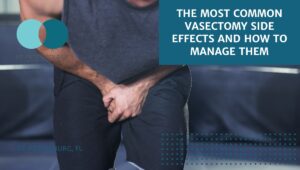 Many males may view a vasectomy procedure as the simplest means to prevent future pregnancies. This can ensure that children are not born into their lives. However, it’s crucial to recognize that vasectomies can be associated with certain side effects. While a vasectomy might be the optimal choice for some couples, it’s essential to consider these potential side effects. In this article, we will discuss the most common vasectomy side effects and how to manage them.
Many males may view a vasectomy procedure as the simplest means to prevent future pregnancies. This can ensure that children are not born into their lives. However, it’s crucial to recognize that vasectomies can be associated with certain side effects. While a vasectomy might be the optimal choice for some couples, it’s essential to consider these potential side effects. In this article, we will discuss the most common vasectomy side effects and how to manage them.
Definition of a Vasectomy
A vasectomy is a surgical procedure performed on a man in order to prevent future pregnancies. This is done by cutting and blocking the vas deferens, which is the tube that carries sperm from the testicles to the penis. Vasectomy is considered to be a permanent form of birth control. However, it is important to note that some cases have resulted in pregnancies following the procedure.
Common Side Effects
Post-operative Pain
One of the most common side effects after a vasectomy is post-operative pain. This pain can range from mild to severe and is usually felt in the area around the scrotum. This pain should not persist for more than one week following the surgery. Typically, it can be managed by taking over-the-counter pain medications or using an ice pack.
Swelling
Swelling is another common side effect following a vasectomy and is usually localized to the scrotum and groin area. This side effect is often seen soon after the surgery and can last anywhere from a couple days to a week. Most cases can be managed with elevating the area and using an ice pack or cold pack, however, if the swelling persists and is accompanied by pain, a doctor should be consulted.
Bruising
Bruising is another common side effect following a vasectomy and is usually localized to the scrotum and groin area. This side effect is often seen soon after the surgery and can last anywhere from a few days to a couple of weeks. Bruising can be managed with over-the-counter medication, however, if the bruising persists, a doctor should be consulted.
Diagnosing and Managing Side Effects
Visit a Doctor for Post-operative Care
It is important to visit a doctor for post-operative care following a vasectomy. A doctor can provide individualized advice for managing common side effects and prescribing any necessary medications. Doctors can also provide advice for activity levels, as too much activity too soon following the procedure can increase the risk of complications.
Use Ice Packs and Over-the-Counter Medications for Pain Relief
To help manage post-operative pain, it is recommended to take over-the-counter pain medications or use an ice or cold pack. This can help reduce the pain and inflammation in the area. It is important to not take more than the recommended dosage for any over-the-counter medications and to follow all directions when using an ice or cold pack.
Follow Post-operative Instructions for Activity Levels
In order to reduce the risk of complications following a vasectomy, it is important to follow post-operative instructions for activity levels. This may include avoiding strenuous activities or activities that involve lifting for a certain period of time. Following these instructions can help ensure that any side effects are minimized and that the surgery is a success.
Potential Complications
Infection
Infection is a potential complication that can occur after a vasectomy. This can present as redness, swelling, and pain in the area that persists beyond the normal post-operative period. If infection is suspected, it is important to contact a doctor as soon as possible in order to get the appropriate treatment.
Painful Intercourse
Painful intercourse is another potential complication that can occur after a vasectomy. While it is rare, it is important to be aware of this potential complication. If a man experiences pain during intercourse that persists or worsens, it is important to contact a doctor as soon as possible.
Conclusion
In conclusion, it is important to be aware of the most common vasectomy side effects and how to manage them. Post-operative pain, swelling, and bruising are the most common side effects after a vasectomy and can usually be managed with ice packs, taking over-the-counter medications, and following post-operative instructions for activity levels. It is also important to be aware of the potential risks of infections and painful intercourse. If any of these side effects persist or worsen, it is important to visit a doctor as soon as possible.
At St Pete Urology, we understand that a vasectomy can be an overwhelming decision and we are here to provide patients with the best possible care. Our experienced staff is dedicated to providing the highest quality of care in a comfortable and welcoming environment. Contact us to learn more about how we can help you achieve your reproductive goals.
Sources:
- “Post-vasectomy pain syndrome”, MayoClinic, https://www.mayoclinic.org/diseases-conditions/post-vasectomy-pain-syndrome/symptoms-causes/syc-20527047
- “Assessing pre- and postoperative activity levels with an accelerometer: a proof of concept study”, NCBI, https://www.ncbi.nlm.nih.gov/pmc/articles/PMC5427573/
- “Review of Vasectomy Complications and Safety Concerns”, NCBI, https://www.ncbi.nlm.nih.gov/pmc/articles/PMC8255399/
Understanding the Vasectomy Procedure: What You Need to Know
Key Takeaways:
1. A vasectomy is a permanent form of contraception for men that prevents pregnancy by blocking the flow of sperm from the testicles to the penis.
2. Preparation for a vasectomy includes discussing potential risks and complications with a doctor, scheduling an appointment at a certified facility and undergoing pre-surgery testing.
3. After the surgery, patients should expect minor pain and swelling, use an alternate form of contraception until the procedure is confirmed successful, and follow-up care with their doctor.
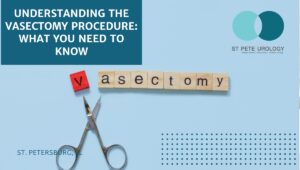 Understanding the Vasectomy Procedure: What You Need to Know
Understanding the Vasectomy Procedure: What You Need to Know
A vasectomy is a permanent form of contraception for men that prevents pregnancy by blocking the flow of sperm from the testicles to the penis. Though the procedure is relatively safe, with proper tools and techniques it is important to understand what is involved. This article aims to provide an overview of the vasectomy procedure and explain the reasons for considering this option. It will also detail what is involved in preparation, surgery, and recovery.
Introduction
A vasectomy is a routine and relatively safe procedure that involves blocking the flow of sperm from the testicles to the penis, making it an extremely effective form of contraception. Men considering the procedure should understand the risks and benefits associated with the procedure, and make sure to discuss the specifics with their doctor.
Overview of the Vasectomy Procedure
A vasectomy is a surgical procedure that is performed under local anesthesia and is relatively quick and simple. During the procedure, a surgeon can access the tubes that transport sperm from the testes to the penis. They use clamps, heat, or a cauterizing device to cut and seal these tubes. Vasectomy does not interfere with male hormones or with the appearance of the patient’s external genitalia. However, it does not protect against sexually transmitted diseases.
Reasons for Considering a Vasectomy
Men may consider having a vasectomy for personal, finance, or medical reasons. If smaller families are desired, couples may consider a vasectomy. They might choose this option if they are sure they do not want any more children. Additionally, a vasectomy may be recommended if a medical condition, such as a genetic disorder, increases the risk of having a baby with birth defects.
In addition, vasectomy is much less expensive than other contraceptive methods such as tubal ligation. So, couples may decide it is the best option to meet their needs.
Description of the Vasectomy Procedure
What Is Involved in the Procedure?
The vasectomy procedure typically takes no more than 30 minutes and is performed in an outpatient setting. During the procedure, the surgeon anesthetizes the scrotum and cuts the connecting tubes through which sperm travels. These tubes are then sealed using heat or clamps and the scrotal incision is closed using sutures.
Once the procedure is completed, the sperm are still present in the seminal vesicles and ejaculatory ducts, but can no longer travel to the penis, making the patient infertile.
Side Effects and Complications
While a vasectomy is generally a safe and relatively simple procedure, as with any medical procedure there are always potential risks or complications. The most common complication is post-vasectomy pain syndrome, which usually subsides within a few months. Other complications include infection, pain, swelling, and bruising.
What to Expect Following the Surgery
Immediately following the procedure, pain, swelling, and bruising may occur, but typically subsides within a few days. Generally, patients can return to work within a few days, but heavy lifting or strenuous activity should be avoided for 1-2 weeks. Sexual activity can usually resume soon after the procedure, however, it is important to use another form of contraception until the doctor confirms that the procedure was successful.
Preparing for a Vasectomy
What to Discuss with Your Doctor
Prior to scheduling the procedure, it is important to have a thorough and informative conversation with your doctor. This discussion should cover the risks and complications associated with the procedure and any underlying medical conditions that could affect the surgery. Your doctor should also provide detailed instructions about preparation for the procedure and what to expect afterwards.
Scheduling Your Appointment
Patients should schedule the procedure at a facility that is certified to perform such operations. It is also important to allow enough time for all tests and consultations that may be necessary prior to the surgery.
Pre-Surgery Testing
Your doctor may require you to have additional testing done, such as a urine test, complete blood count, and a semen analysis. These tests are done to make sure the patient is in good health and has the correct hardware that is needed for a successful surgery.
What to do and Not do Before and After the Procedure
Before the surgery, it is important to plan ahead. Make sure to have someone available to drive you home after the procedure, and make arrangements to take a few days off work to allow time for recovery. Additionally, patients should avoid alcohol for two days before the surgery, and avoid any strenuous activity for several days afterwards.
Aftercare and Recovery
Expected Recovery Time
Recovery from a vasectomy typically takes a few days and includes minor pain and swelling. Pain typically subsides within a few days and patients are usually able to resume most activities within a week.
Follow-up Care
It is common for patients to experience some residual swelling and flesh colored lumps around the scrotum for up to six weeks. Your doctor may also ask you to provide a semen sample three months after the procedure to make sure the tubes remain blocked.
How to Make Sure the Procedure Was Successful
It is important to use another form of contraception until a semen sample confirms that the procedure was successful. If a sperm sample is not produced six weeks after the operation, your doctor may recommend another semen sample at three months post-surgery.
When Is It Safe to Resume Sexual Activity?
Typically, sexual activity can resume soon after the surgery. However, it is important to use an alternate form of contraception until the doctor confirms that the procedure was successful.
Conclusion
A vasectomy is a highly effective form of contraception for men and is a safe and routine procedure. Prior to scheduling the procedure, it is important to talk to your doctor in order to receive instructions and advice on preparation, surgery, and recovery. With proper aftercare and follow-up care, the procedure can be successful and help couples reach their family planning goals.
For more information or to schedule an appointment to discuss the vasectomy procedure, visit St Pete Urology. We are a urology practice located in St Petersburg, Florida, dedicated to providing the highest quality of care and specialized treatment for our patients.
Sources:
- “Vasectomy: Surgery Overview.” Cleveland Clinic, 19 March 2018, https://my.clevelandclinic.org/health/treatments/4423-vasectomy.
- Guzzo, Thomas J. “5 Reasons to Consider a Vasectomy.” Best Urology Clinic, 11 March 2021, https://www.besturologyclinic.com/blog/5-reasons-to-consider-a-vasectomy.
- “Vasectomy.” Eunice Kennedy Shriver National Institute of Child Health and Human Development, National Institutes of Health, U.S. Department of Health and Human Services, 7 September 2021, https://www.nichd.nih.gov/health/topics/vasectomy/conditioninfo/.
The Pros and Cons of Vasectomy
 Penis enhancement surgery is a procedure to correct structural and functional problems of the penis. It may be recommended after an injury, defect, or loss of function. But usually, it is a corrective measure for a micropenis or a buried penis. Both of which cause functional issues with urinating, sexual intercourse, or hygiene.
Penis enhancement surgery is a procedure to correct structural and functional problems of the penis. It may be recommended after an injury, defect, or loss of function. But usually, it is a corrective measure for a micropenis or a buried penis. Both of which cause functional issues with urinating, sexual intercourse, or hygiene.
In rare cases, the procedure may be considered for making the penis longer or larger. It may also be used to make the stomach smaller in order to allow the penis to appear longer and wider. However, surgery to increase the size or width of the penis is medically discouraged. It is a deeply personal decision that requires careful consideration.
That’s because most men who usually think they have a small penis tend to actually have a normal-sized penis. Also, most of the penis enhancement claims are false and tend to involve techniques and products that may be harmful to the penis.
Alternatives to surgery
- Jelqing exercises
Jelqing is a natural penis enlargement exercise involving a hand-over-hand rolling motion to increase blood flow to the head of the penis and stretch the organ. Though a fairly safe practice that can enhance the penis, it is not backed by enough medical studies. And it may lead to pain, irritation, or scar tissue formation if done too often or aggressively.
- Pills, potions, and lotions
While there are numerous penile enlargement vitamins, pills, herbal preparations, hormones, and lotions, most of the claims about them aren’t supported by evidence. Some may even interfere or interact with other medications or be harmful to users.
- Penile extenders
Penile extenders are non-invasive devices that use traction to stretch the penis. Studies have reported that extenders help to increase the length of a flaccid penis by more than 1.5 centimeters after 3 months of use.
But more research is necessary to assess their safety and effectiveness. Plus, they are uncomfortable and cumbersome to use, and can overstretch the penis causing nerve damage, bruising, or blood clots.
- Vacuum pump
Though they are designed to treat erectile dysfunction, some people use them to occasionally “exercise” and stretch their penis. In the process, they can trigger tissue damage and cause erectile problems.
- Clamps and rings
Clamps and rings are used by some people to stretch and elongate their penis. The devices are placed around the base of an erect penis to reduce blood flow out of the penis. While wearing one of these devices may temporarily enlarge the penis, having it on for more than 30 minutes may cut off blood flow and damage penile tissues.
What are the pros and cons of penile enhancement surgery?
Typically, a urologist recommends penile enhancement surgery to correct an injury, treat a defect, or improve function of the organ. Only in very rare cases can the doctor recommend surgery to increase the length or width of the penis.
That’s because penis enhancement surgery comes with the risk of serious complications such as scarring, pain, infection, loss of penile sensation, and erectile dysfunction.
Pros of penis enhancement surgery
- Helps to correct a micropenis – defined as a very small penis. A micropenis is a condition you’re born with, but which needs correction because it causes functional problems.
- Helps to correct a buried penis – defined as a penis buried under the skin from your stomach, thighs or scrotum. A buried penis can be a congenital condition or a result of aging.
- Helps to restore a functional penis by correction of penile abnormalities caused by injuries or disease. Penile abnormalities may make it difficult to urinate while standing up or hinder penetrative sexual intercourse.
- Helps to achieve a satisfactory appearance of the penis, particularly in those with persistent, bothersome, and embarrassing concerns about their penis size or width.
- Helps to create a new sense of masculinity and sexual potency, which in turn improves personal relationships, overall mood, and productivity in daily work.
- Helps to increase confidence and self-esteem by achieving a penis length and girth that meets personal goals and expectations.
Cons of penis enhancement
- Is associated with surgery risks such possible infection, bleeding, or damage to nerve endings.
- There may be adverse reactions to anesthesia.
- It may produce a lop-sided penis appearance, where the penis seems to hang from the scrotum instead of from the abdomen.
- Fat used to widen or enlarge the penis can be reabsorbed, which eventually reduces the width of the enhanced penis.
Safe, effective penis enhancement
At St Pete Urology, we perform penis enhancement surgery on a regular basis to correct congenital and acquired micropenis. The goal of the surgery is usually to restore a functional penis size in order to achieve normal standing urination, satisfying sexual intercourse, and enhanced quality of life.
Occasionally, we perform penis enhancement procedure on men with normal length penises, but who perceive themselves to have small ones—something that is usually a psychological condition. But for such a procedure, a lot more consultations and a multidisciplinary approach are usually necessary to come up with a highly individualized surgery that meets patient goals and expectations.
For more information on penis enhancement and other procedures for treating urologic disorders, visit the site “St Pete Urology.”
What are the Success Rates of a Vasectomy Reversal?
 A vasectomy reversal is the surgical procedure to undo a vasectomy. The operation involves reconnecting each vas deferens that was cut and sealed off during vasectomy. Once reconnected, each vas deferens becomes a channel through which sperm can again pass through from the testicle into the semen.
A vasectomy reversal is the surgical procedure to undo a vasectomy. The operation involves reconnecting each vas deferens that was cut and sealed off during vasectomy. Once reconnected, each vas deferens becomes a channel through which sperm can again pass through from the testicle into the semen.
The reversal procedure is a more difficult and delicate procedure compared to the vasectomy. It is performed with the aid of a powerful surgical microscope that helps to magnify the vas deferens by as much as forty times in size. And most importantly, the surgery demands a high degree of skill and experience to carry out.
What is a successful vasectomy reversal?
A successful vasectomy reversal not only restores sperm in semen, but also enables a man to get his partner pregnant. Many men undergo the reversal procedure due to loss of a child, change of heart or remarriage and with their motivation being the opportunity to have more children.
So the measure of a successful reversal is fundamentally on whether or not a man is able to make his partner pregnant. Unfortunately, this is not a straightforward measure as many factors are involved in achieving a pregnancy.
For instance, getting a pregnancy depends on the man’s age, age of his partner, and on the health and motility of his sperm. This means that having a vasectomy reversal after the age of 50 years when the number of healthy sperm and their motility has reduced significantly may not be successful. In contrast, having a vasectomy reversal done when a man is younger and with a younger partner may increase the chances of success of the procedure.
Success of a vasectomy reversal also depends on the type of vasectomy procedure a man had and how long it has been in place. The more time after a vasectomy, the more likely you are to develop scar tissue in the vas deferens that will make it difficult to have sperm pass through the tube and reach semen.
What are the success rates of a vasectomy reversal?
The success rates of vasectomy reversal range from 10-90 percent depending on the type of procedure, time that has elapsed since the vasectomy, age of the partner, the surgeon’s experience and training, and whether you had fertility issues before the vasectomy.
When the reversal procedure is done soon after the vasectomy, the chances of success are quite high. In fact, if a vasectomy is reversed within 10 years after the procedure, there is more than 95-percent possibility of having sperm back in the ejaculate and over 50-percent chance of achieving pregnancy. But a reversal performed more than 15 years after the vasectomy has a lower potential of restoring sperm back in semen and as low as 30-percent rate of pregnancy.
Success rates of vasectomy are:
- Up to 97 percent success rate of sperm in semen and 76-percent rate of pregnancy when reversal is done within 3 years after the vasectomy.
- Up to 88 percent success rate of sperm in semen and 55 percent rate of pregnancy when reversal is done between 3-8 years after the vasectomy.
- Up to 79 percent success rate of sperm in semen and 44 percent pregnancy rate when the reversal is done 9-14 years after the vasectomy.
- Up to 71 percent success rate of sperm in semen and 30 percent rate of pregnancy when the reversal is done 15-19 years after the vasectomy.
- Up to 52-percent sperm in semen and less than 10 percent rate of pregnancy when the reversal is done after 20 years since the vasectomy.
The reversal technique used and its eventual success depend on the part where the surgeon finds sperm during the procedure. If the surgeon finds sperm within the blocked vas deferens, the vasectomy is reversed by simply reconnecting the two ends of the vas deferens back together. This is a simple procedure that offers 75-97 percent chance of restoring sperm in semen and over 50 percent chance of achieving pregnancy.
But when there is no sperm in the tubes, which is often due to a blockage nearer the testicles, the surgeon will often perform the vasoepididymostomy procedure. During vasoepididymostomy, the vas deferens is connected to the epididymis. This procedure gives a 58-85 percent success in having sperm in semen and produces an average 34 percent rate of pregnancy.
For more information on vasectomy and vasectomy reversal, visit the site “St Pete Urology.”
Can a vasectomy reverse itself after 14 years?
A vasectomy is one of the safest and most effective birth control methods. But like other medical procedures, it isn’t foolproof.
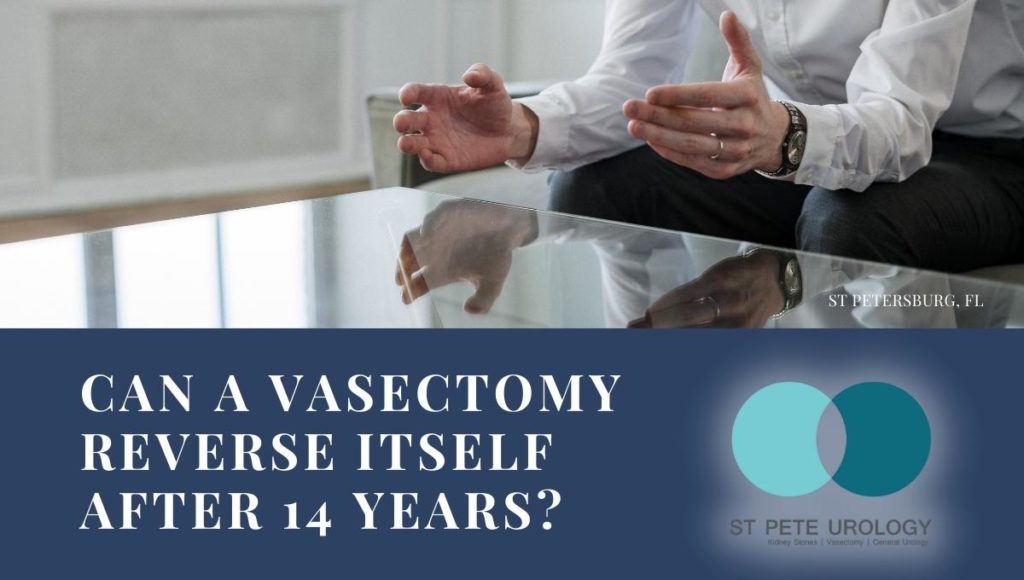
There is a possibility that a vasectomy can fail to prevent pregnancy in extremely rare cases with roughly a 1-percent chance of failure.
Though vasectomy failures can be due to various reasons, several cases are due to a reversal of the procedure over time.
How can a vasectomy reverse itself?
In rare instances, a vasectomy can reverse itself and is known to occur in about 0.025 percent of cases, equivalent to 1 reversal in 4,000 vasectomies. Such a reversal involves reconnection of the vas deferens after successful surgery and an effective post-vasectomy plan.
Remember that during a vasectomy, the vas deferens—the two tubes that carry sperm from the testicles to the urethra—are cut and sealed off to block sperm from reaching semen. The channel in the vas deferens is broken at the point where it is cut to eliminate the passageway of the sperm to combine with the semen.
However, in some cases, the vas deferens grow back several years after the procedure. The growth may continue until a connection is recreated, allowing the free flow of sperm to the urethra.
An extremely rare and successful reconnection can occur after 10 to 14 years or more and is usually almost impossible to notice.
Most men only realize that their vas deferens have reconnected after their sexual partners get pregnant.
What can make a vasectomy reverse itself?
After a vasectomy, sperm may leak from the vasectomy site or a rupture and directly into the epididymis. Since sperm have immune system stimulating properties (antigenic qualities), it recognizes sperm as foreign and attacks them.
The sperm leakage triggers an inflammatory reaction that causes the body to develop pockets to trap the sperm in scar tissues and inflamed cells.
With time, spheres of cells called sperm granulomas form and produce nodules in the vas deferens that may grow and result in the reconnection of the vas deferens.
The risk of a reversal increases with the presence of sperm tissue at the vasectomy site.
Another reversal mechanism is scar tissue.
With cells present after a vasectomy forming tiny channels that allow sperm to squirm their way through the tiny tears in the scar tissue, small drainage channels appear in the tissue on the ends of the severed vas deferens. Over time, these channels may reconnect to the divided vas deferens, providing a pathway for sperm to the seminal vesicles. The risk of a reversal via scar tissue increases with open-ended vasectomy, where only one end of the vas deferens is closed.
However, you shouldn’t be overly concerned if you consider a vasectomy or have already undergone the procedure.
The chances of a reversal are pretty rare—almost negligible—and extremely unlikely in most cases.
At St. Pete Urology, we are proud of our excellent record of successful vasectomies. Our skilled and experienced urologists understand the factors that may lead to vasectomy failure, including non-severance of the vas deferens, non-observance of a period of sperm-free ejaculate, reconnection of the vas deferens, and duplication of the vas deferens. So we tailor and conduct every vasectomy under strictest adherence to best practices.
Call St. Pete Urology today for more information on vasectomy and vasectomy reversal.
Can you still have Orgasm after Vasectomy?
 Men, we all desire to be good husbands and partners. Many of you may have seen your wife or partner experience the adverse effects of some contraception. Some will want to help alleviate this unfortunate circumstance.
Men, we all desire to be good husbands and partners. Many of you may have seen your wife or partner experience the adverse effects of some contraception. Some will want to help alleviate this unfortunate circumstance.
The option of undergoing vasectomy may come up. This procedure is one big step to take a lead role in family planning and protect your partner. However, you may also have concerns about how it will affect your sex life afterward.
The good news is, vasectomy will not adversely affect your sex life.
It will neither reduce your sex drive nor affect your ability to have an erection. It will not affect your ability to ejaculate or have any difference in the amount of semen you ejaculate.
No effect on testosterone production
Your male characteristics depend on the hormone testosterone. Produced in your testicles and responsible for secondary sexual characteristics, testosterone is the hormone that maintains your libido (sex drive), sensation, and ability to have an erection and an orgasm.
An average testosterone level after vasectomy means you maintain the same level of sexual performance and satisfaction after the procedure.
So does a vasectomy affect your testosterone level? No. Your testicles continue to produce testosterone after the procedure, just as they did before the surgery. The operation is done on the vas deferens and not on your testicles, which means there are no effects on testosterone production. Plus, it means you continue to have normal erections, ejaculations, and orgasms.
If you experience a drop in testosterone after vasectomy, the reduction may be unrelated to the procedure. Such a reduction is often due to diminished function of the testes (hypogonadism), which is linked to age.
Hypogonadism affects 1 in 50 men aged 40-79 years. It is more common in men with diabetes, kidney disease, heart disease, or those taking certain medications, such as steroids. It may also be due to stress, depression, or too much alcohol.
If you notice any drop in your sex drive after vasectomy or feel you might have symptoms of low testosterone, speak with your doctor for help.
Normal ejaculations
A vasectomy does not significantly affect the quantity of the ejaculate. While the procedure ensures that the sperm made in the testicles do not pass through the vas deferens to reach the urethra, it doesn’t noticeably change the quantity of fluid you ejaculate.
In a typical ejaculation, the semen produced in your seminal vesicles and prostate gland forms 95-98 percent of the ejaculate. And so, since sperm only makes 2-5 percent of the ejaculate, preventing sperm from being included in the semen doesn’t make a big difference in the volume of the ejaculate. You will not even realize the difference in your ejaculations.
Remember that the procedure does not stop sperm production. Your testicles will continue to secrete sperm throughout your life; only that the sperm will not reach the urethra to be added to the semen before ejaculation.
During a vasectomy, your vas deferens is cut and blocked to stop sperm and make it impossible for them to travel to the urethra. The sperm dies and is absorbed by the lining (membrane) of the epididymis, where they dissolve naturally. The absorption process doesn’t interfere with testosterone production, erections, or orgasms.
Enhanced orgasms
With a vasectomy, you will feel relieved from the anxiety or stress of an unplanned pregnancy. And, with that freedom, your lovemaking will be more spontaneous, sensual, frequent, and intense.
Recent studies have shown that the procedure isn’t only reliable but boosts sex drive in men and ensures stronger erections and better orgasms without the risk of pregnancy.
Safe, effective vasectomy
Want to have a vasectomy but have questions before the procedure?
At St Pete Urology, we do vasectomies every week and guide men to make the right family planning decisions. We will listen to your concerns, give you the right advice, and help you make an informed decision.
Over the years, we have seen our clients undergo vasectomy procedures and report results that make us proud. We are happy that our patients retain the highest level of sex drive, firmer erections, unchanged ejaculation, and regular orgasms after the procedure.
If you’re considering having a vasectomy at St Pete Urology, you shouldn’t fear it would affect your sex drive or orgasms. We can guarantee that your sexual performance and satisfaction will only get better.

